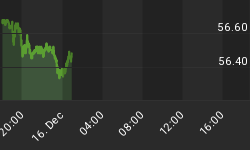The good news is:
• The decline this month, so far, has not generated many newlows.
My guess that the low of Thursday January 13 would be the low for this current decline was a little optimistic. Of the major indices, only the Russell 2000 (R2K) has not broken below the January 13 low. That is a good thing because I look for the secondaries to lead both up and down.
The chart below shows the S&P 500 (SPX) in green, the R2K in red and a FastTrack relative strength indicator called Accutrack as a histogram in yellow. The chart covers the period from mid-July 2004 to last Friday. Accutrack had a peak in early December indicating the high in performance of the R2K to the SPX. After falling to a low January 13, Accutrack has been rising indicating the secondaries have been stronger than the blue chips.

The next 2 charts show the SPX and R2K with channel lines drawn by first drawing a line across the tops then drawing a line parallel to the first line across two groups of bottoms. By the more inclusive definition, the SPX is still within the channel that began last August. It is pretty difficult to make the same argument for the R2K as the recent lows are below the bottom of any previously defined channel. There is a horizontal support-resistance line drawn on each chart through the recent levels and some congestion that occurred back in November. It would not be surprising to see those levels, 1170 for the SPX and 610-615 for the R2K act as support.


Measured by the SPX, January is second to December as the strongest month of the year.
The table below shows the change in the SPX in January and for the whole year during the first year of the presidential cycle. Januarys have been up 60% of the time while and the whole year has been up 47% of the time and the return in January has averaged 55% of the total return for the year.
Every time January has been down the year was down and the loss for the year exceeded the loss in January.
We are on track for a down January.
| Presidential Year 1 | |||
| Jan | Year | ||
| 1929-1 | 3.7% | -11.9% | |
| 1933-1 | 1.6% | 46.6% | |
| 1937-1 | 4.8% | -38.6% | |
| 1941-1 | -3.9% | -17.9% | |
| 1945-1 | 1.1% | 30.7% | |
| Avg | 1.45% | 1.79% | |
| 1949-1 | 1.8% | 10.3% | |
| 1953-1 | -0.6% | -6.6% | |
| 1957-1 | -3.2% | -14.3% | |
| 1961-1 | 7.3% | 23.1% | |
| 1965-1 | 4.0% | 9.1% | |
| Avg | 1.85% | 4.30% | |
| 1969-1 | -0.9% | -11.4% | |
| 1973-1 | -2.6% | -17.4% | |
| 1977-1 | -4.6% | -11.5% | |
| 1981-1 | -5.0% | -9.7% | |
| 1985-1 | 8.6% | 26.3% | |
| Avg | -0.89% | -4.73% | |
| 1989-1 | 8.0% | 27.3% | |
| 1993-1 | 0.8% | 7.1% | |
| 1997-1 | 6.7% | 31.0% | |
| 2001-1 | 6.4% | -13.0% | |
| Avg | 5.48% | 13.10% | |
| Averages | 1.7% | 3.1% | Whole database |
| Win% | 60% | 47% | |
There has been some publicity about a decennial pattern in which years ending in 5 are strong and in fact have never been down. The table below shows the performance of Dow Jones Industrial average (DJIA) in January and for the year as a whole for every year ending in 5. Not only have years ending in 5 all been up, but the average return has been 31.1%.
| DJIA | Jan | Year |
| 1885-1 | 0.0% | 25.4% |
| 1895-3 | 0.0% | 1.7% |
| 1905-1 | 1.3% | 38.2% |
| 1915-3 | 4.6% | 81.7% |
| 1925-1 | 1.6% | 30.0% |
| 1935-3 | -2.7% | 38.5% |
| 1945-1 | 0.7% | 26.6% |
| 1955-3 | 0.0% | 20.8% |
| 1965-1 | 3.8% | 10.9% |
| 1975-3 | 11.3% | 38.3% |
| 1985-1 | 7.3% | 27.7% |
| 1995-3 | 0.1% | 33.5% |
If we do not have a rally that brings January into the black, some record will be broken.
In 1998 we saw a textbook example of a top.
The R2k peaked in April and the SPX peaked in July then both indices collapsed into the October low.
The chart below shows that period with the R2K in red and the SPX in green.

The next chart shows the same two indices ending last Friday. So far there is no hint of a topping pattern similar to what we saw in 1998.

There is little evidence that the current decline is ending, but the market is oversold by nearly every measure. The end of January and first few days of February are seasonally strong so a rally is likely.
I expect the major indices to be higher on Friday January 28 than they were on Friday January 21.
My guess that the lows of January 13 would be the bottom was optimistic and my positive forecast for last week was a miss.
















